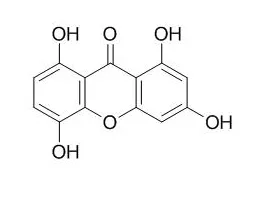| In vitro: |
| Mutat Res. 1985 Jun-Jul;150(1-2):141-6. | | Mutagenicities of xanthone derivatives in Salmonella typhimurium TA100, TA98, TA97, and TA2637.[Pubmed: 3889613] |
METHODS AND RESULTS:
The mutagenicities of naturally occurring xanthones were tested in Salmonella typhimurium TA100, TA98, TA97, and TA2637 by the preincubation method. Xanthydrol, gentisein, gentisin, isogentisin, 1-hydroxy-3,7-dimethoxyxanthone, 1,3,7-trimethoxyxanthone, Desmethylbellidifolin, bellidifolin and dimethylbellidifolin were mutagenic, but unsubstituted xanthone was not mutagenic to TA100, TA98, TA97 and TA2637 with or without a metabolic activation system.
CONCLUSIONS:
The beta-O-glucosides, norswertianolin and swertianolin, were only mutagenic when a metabolic activation system containing beta-glucosidase was used, and the C-glucoside mangiferin was not mutagenic even with this system. | | Journal of the American Oil Chemists’ Society, 1994 , 71 (10) :1095-9. | | Antioxidative components, xanthone derivatives, in Swertia japonica Makino.[Reference: WebLink] | Substances with antioxidative properties were obtained from an ether extract ofSwertia japonica Makino.
METHODS AND RESULTS:
Six active components of the extract were isolated and identified as methylbellidifolin, methylswertianin, swertianin, bellidifolin, norswertianin and Desmethylbellidifolin. These six xanthone derivatives were shown to possess different antioxidant activities by chemiluminescent assay. The antioxidative activities of bellidifolin, norswertianin and Desmethylbellidifolin were higher than those of butylated hydroxytoluene (BHT) and α-tocopherol. On autoxidation of methyl linoleate, bellidifolin had activity similar to that of BHT.
CONCLUSIONS:
On the basis of the data present on antioxidative properties and data reported on the mutagenicities of the xanthones, both activities were shown to give a good correlation. | | Planta Medica, 2009 , 75 (9) :1058-9. | | Antibacterial activity of phenolic compounds from Mongolian plants.[Reference: WebLink] |
METHODS AND RESULTS:
Fourty seven pure compounds such as flavonol derivatives (20), simple penolics (9), xanthone derivatives (13), luteolin, cynaroside, prunasin, euscaphic acid and (z)-hexenyl-O-α-rhamnopyranosyl-(1-6)-β-D-glucopyranoside isolated from Mongolian some medicinal plants have been tested against bacterial strains as Staphylococcus aureus (Sa), Micro-coccus luteus (Ml), Enterococcus faecalis (Ef), Pseudomonas aeruginosa (Pa) and Escherichia coli (Ec) by the disk diffusion method, respectively.
Kanamycin was used as a standard antibiotic. From tested compounds only kaempferol, quercetin, ethylgallate, gallic acid and Desmethylbellidifolin exhibited at the dose of 200μg/disk a significant inhibition of the growth of Sa, while luteolin was active only at the high dose 750μg/disk. Ethylgallate demonstrated a great activity against the growth of Ml at the dose of 20μg/disk, while Desmethylbellidifolin was active at 200μg/disk. Quercetin showed activity against Ml only at the high dose of 750μg/disk. Moreover, ethylgallate significantly inhibited the growth of Ef at 200μg/disk and was faint against Pa only at the high dose of 1000μg/disk. Whereas, Desmethylbellidifolin was active against the growth of Ef and Ec only at the high dose 750 μg/disk.
CONCLUSIONS:
It has been determined that kaempferol, quercetin, gallic acid and luteolin did not show any activity against the growth of Ef, Ec and Pa even at the highest dose 1500μg/disk. However, all other compounds including flavonol, flavone and xanthone glycosides even at the highest dose 1500μg/disk were found not active against the growth of all bacterial strains. This evidence confirmed that antibacterial activity of aglycones of phenolic compounds are much higher than the related glycosides [1,2]. In particular, ethylgallate, the simple phenol, exhibited more prominent activity than all other tested compounds. |
|






 Cell. 2018 Jan 11;172(1-2):249-261.e12. doi: 10.1016/j.cell.2017.12.019.IF=36.216(2019)
Cell. 2018 Jan 11;172(1-2):249-261.e12. doi: 10.1016/j.cell.2017.12.019.IF=36.216(2019) Cell Metab. 2020 Mar 3;31(3):534-548.e5. doi: 10.1016/j.cmet.2020.01.002.IF=22.415(2019)
Cell Metab. 2020 Mar 3;31(3):534-548.e5. doi: 10.1016/j.cmet.2020.01.002.IF=22.415(2019) Mol Cell. 2017 Nov 16;68(4):673-685.e6. doi: 10.1016/j.molcel.2017.10.022.IF=14.548(2019)
Mol Cell. 2017 Nov 16;68(4):673-685.e6. doi: 10.1016/j.molcel.2017.10.022.IF=14.548(2019)